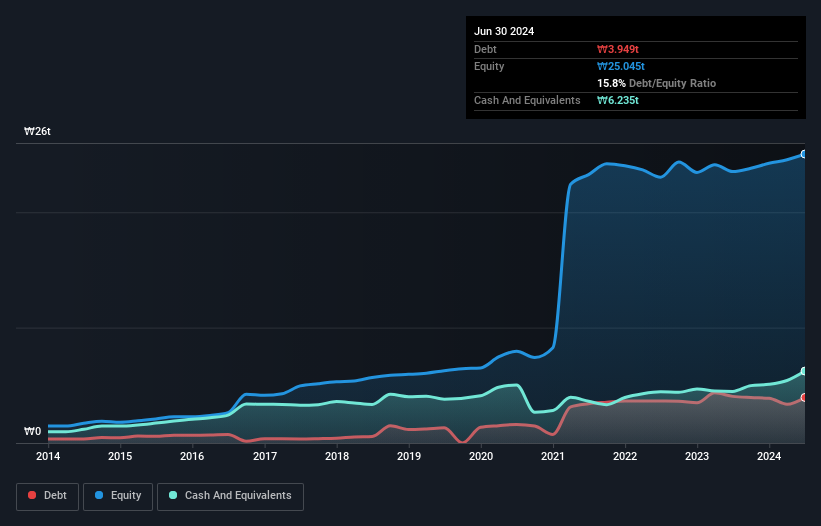- South Korea
- /
- Interactive Media and Services
- /
- KOSE:A035420
NAVER (KRX:035420) Has A Rock Solid Balance Sheet
The external fund manager backed by Berkshire Hathaway's Charlie Munger, Li Lu, makes no bones about it when he says 'The biggest investment risk is not the volatility of prices, but whether you will suffer a permanent loss of capital.' It's only natural to consider a company's balance sheet when you examine how risky it is, since debt is often involved when a business collapses. We can see that NAVER Corporation (KRX:035420) does use debt in its business. But is this debt a concern to shareholders?
Why Does Debt Bring Risk?
Debt and other liabilities become risky for a business when it cannot easily fulfill those obligations, either with free cash flow or by raising capital at an attractive price. Ultimately, if the company can't fulfill its legal obligations to repay debt, shareholders could walk away with nothing. While that is not too common, we often do see indebted companies permanently diluting shareholders because lenders force them to raise capital at a distressed price. Of course, plenty of companies use debt to fund growth, without any negative consequences. The first thing to do when considering how much debt a business uses is to look at its cash and debt together.
Check out our latest analysis for NAVER
What Is NAVER's Net Debt?
The chart below, which you can click on for greater detail, shows that NAVER had ₩3.95t in debt in June 2024; about the same as the year before. But it also has ₩6.24t in cash to offset that, meaning it has ₩2.29t net cash.

How Healthy Is NAVER's Balance Sheet?
According to the last reported balance sheet, NAVER had liabilities of ₩6.04t due within 12 months, and liabilities of ₩5.22t due beyond 12 months. On the other hand, it had cash of ₩6.24t and ₩1.72t worth of receivables due within a year. So its liabilities total ₩3.31t more than the combination of its cash and short-term receivables.
Of course, NAVER has a titanic market capitalization of ₩26t, so these liabilities are probably manageable. Having said that, it's clear that we should continue to monitor its balance sheet, lest it change for the worse. While it does have liabilities worth noting, NAVER also has more cash than debt, so we're pretty confident it can manage its debt safely.
Another good sign is that NAVER has been able to increase its EBIT by 24% in twelve months, making it easier to pay down debt. When analysing debt levels, the balance sheet is the obvious place to start. But ultimately the future profitability of the business will decide if NAVER can strengthen its balance sheet over time. So if you want to see what the professionals think, you might find this free report on analyst profit forecasts to be interesting.
But our final consideration is also important, because a company cannot pay debt with paper profits; it needs cold hard cash. While NAVER has net cash on its balance sheet, it's still worth taking a look at its ability to convert earnings before interest and tax (EBIT) to free cash flow, to help us understand how quickly it is building (or eroding) that cash balance. Over the last three years, NAVER recorded free cash flow worth a fulsome 82% of its EBIT, which is stronger than we'd usually expect. That puts it in a very strong position to pay down debt.
Summing Up
While NAVER does have more liabilities than liquid assets, it also has net cash of ₩2.29t. The cherry on top was that in converted 82% of that EBIT to free cash flow, bringing in ₩1.9t. So is NAVER's debt a risk? It doesn't seem so to us. Over time, share prices tend to follow earnings per share, so if you're interested in NAVER, you may well want to click here to check an interactive graph of its earnings per share history.
If, after all that, you're more interested in a fast growing company with a rock-solid balance sheet, then check out our list of net cash growth stocks without delay.
Valuation is complex, but we're here to simplify it.
Discover if NAVER might be undervalued or overvalued with our detailed analysis, featuring fair value estimates, potential risks, dividends, insider trades, and its financial condition.
Access Free AnalysisHave feedback on this article? Concerned about the content? Get in touch with us directly. Alternatively, email editorial-team (at) simplywallst.com.
This article by Simply Wall St is general in nature. We provide commentary based on historical data and analyst forecasts only using an unbiased methodology and our articles are not intended to be financial advice. It does not constitute a recommendation to buy or sell any stock, and does not take account of your objectives, or your financial situation. We aim to bring you long-term focused analysis driven by fundamental data. Note that our analysis may not factor in the latest price-sensitive company announcements or qualitative material. Simply Wall St has no position in any stocks mentioned.
About KOSE:A035420
NAVER
Provides online search portal and information services in South Korea and internationally.
Flawless balance sheet with solid track record.
Similar Companies
Market Insights
Community Narratives



